Smeg SOA330X1 User Manual

USE & INSTALLATION MANUAL
BUILT-IN OVEN

ENGLISH
THANK YOU FOR YOUR TRUST AND FOR BUYING THIS APPLIANCE.
PLEASE READ THIS MANUAL CAREFULLY. IT CONTAINS ALL NECESSARY INSTRUCTIONS TO CONVERT THE GAS SUPPLY OF THIS PRODUCT.
IMPORTANT:
Save for the local electric inspector's use
Installer: Leave installation instructions with the homeowner
Homeowner: Keep installation instructions for future reference.
Write down the model and serial numbers before installing the range.
Both numbers are found on the model/serial ID plate, located on the oven door frame.
Model # _______________________
Serial # _______________________
2

Use & Installation Manual |
ENGLISH |
Table of Contents |
|
IMPORTANT SAFETY INSTRUCTIONS .......................................................................................... |
5 |
Product Features .............................................................................................................................. |
6 |
About Your Oven ......................................................................................................................... |
6 |
Cooling Fan ................................................................................................................................ |
6 |
Rack Positions ............................................................................................................................ |
6 |
Baking Elements ......................................................................................................................... |
7 |
Grilling Element .......................................................................................................................... |
7 |
Convection Element .................................................................................................................... |
7 |
About Convection Ovens ............................................................................................................ |
7 |
The Control Panels ........................................................................................................................... |
8 |
Oven Modes ....................................................................................................................................... |
9 |
General Oven Information ................................................................................................................ |
10 |
General Oven Tips ............................................................................................................................ |
11 |
Oven Racks ....................................................................................................................................... |
11 |
Setting the Clock and Timer ............................................................................................................. |
13 |
Selecting the Oven Mode .................................................................................................................. |
14 |
Time Oven Mode Operation .............................................................................................................. |
15 |
Meat Probe ......................................................................................................................................... |
16 |
Bake Tips and Techniques ............................................................................................................... |
17 |
Convection Bake Tips and Techniques ........................................................................................... |
18 |
Convection Roast Tips and Techniques .......................................................................................... |
20 |
Convection Broil (Grill) Tips and Techniques ................................................................................. |
22 |
Broil (Grill) Tips and Techniques ..................................................................................................... |
23 |
Special Features ............................................................................................................................... |
24 |
Sabbath Mode Instruction ................................................................................................................ |
24 |
Care & Cleaning ................................................................................................................................ |
26 |
Self-Cleaning Function ..................................................................................................................... |
27 |
Setting the Self-Clean Mode ............................................................................................................. |
28 |
Do-it-Yourself Maintenance Oven Door Removal ........................................................................... |
29 |
Replacing an Oven Light .................................................................................................................. |
30 |
Solving Baking Problems ................................................................................................................. |
31 |
Solving Operational Problems ......................................................................................................... |
32 |
If You Need Assistance or Service .............................................................................................. |
32 |
Installation Introduction ................................................................................................................... |
33 |
Tools You Will Need .................................................................................................................... |
33 |
Power Requirements .................................................................................................................. |
33 |
Choosing Oven Location ............................................................................................................. |
33 |
Steps For Installation .................................................................................................................. |
33 |
Technical Data ................................................................................................................................... |
34 |
Single Oven ................................................................................................................................ |
34 |
Double Oven ............................................................................................................................... |
34 |
Wall Installation, Single Oven .......................................................................................................... |
35 |
Wall Installation, Double Oven ......................................................................................................... |
36 |
Electrical Supply ............................................................................................................................... |
37 |
3

ENGLISH |
Use & Installation Manual |
Wiring Requirements .................................................................................................................. |
37 |
Connecting The Oven To The Mains ........................................................................................... |
37 |
Final Check List ................................................................................................................................. |
38 |
This appliance is in compliance with following European directives: 2006/95/CE (LVD), 2004/108/CE (EMC), 2002/95/CE (RoHS), 2002/96/CE (WEEE), 2002/40/CE.
4

|
Use & Installation Manual |
ENGLISH |
|
|
|
Use & Installation Manual |
|
|
|
|
|
|
|
|
|
IMPORTANT SAFETY INSTRUCTIONS
WARNING - When using this appliance, basic safety precautions should always be followed to reduce the risk of fire, electric shock, and/or injury to persons, including the following:
1.Read All Instructions before Using the Oven.
2.Proper Installation - Be sure your appliance is properly installed and grounded by a qualified technician. Have the installer show you where the fuse or breaker box is located and how to turn off the power to the oven.
3.Do Not Operate the Oven if it is Damaged or not working Properly including broken glass: electric shock may occur. Disconnect it from the Mains and Call Service.
4.Never Use Your Appliance for Warming or Heating the Room.
5.Do Not Leave Children Alone - Children should not be left alone or unattended in area where the appliance is in use. They should never be allowed to sit or stand on any part of the appliance. Children should be supervised to ensure that they do not play with the appliance.
6.Do Not Touch Heating Elements or Interior Surfaces of Oven - Heating elements may be hot even though they are dark in color. Interior surfaces of the oven, including racks become hot enough to cause serious burns. Accessible parts may become hot during use. Young children should be kept away. Do not touch or let clothing or other flammable material come into contact with the heating elements or interior surfaces or racks of the oven during or immediately after use. During the oven operation, the front is heated as well; consequently keep children clear of the oven, specially during self-cleaning. Allow the oven to cool.
7.Wear Proper Apparel - Loose-fitting or hanging garments should never be worn while using the appliance. Fabric may ignite and result in personal injury.
8.Use Only Dry Oven Gloves - Moist or damp oven gloves on hot surfaces may result in burns from steam. Do not let oven gloves touch hot heating elements. Do not use a towel or other bulky cloth.
9.User Servicing - Do not repair or replace any part of the appliance unless specifically recommended in the manual. All other service should be referred to a qualified technician.
10.Storage in or on the Appliance - Flammable materials should not be stored in an oven or near surface units.
11.Do Not Use Water on Grease Fires - Smother fire or flame or use dry chemical or foam type extinguisher.
12.Use Care when Opening Door - Let hot air or steam escape before removing or replacing food.
13.Do Not Heat Unopened Food Containers - Build-up of pressure may cause the container to burst and result in injury.
14.Keep Oven Vent Ducts Unobstructed.
15.Placement of Oven Racks - Always place oven racks in desired location while oven is cool. If rack must be moved while oven is hot, do not let the oven glove contact the hot heating element in the oven.
16.It is recommended that not abrasive detergents and no steam cleaning equipment are used.
17.Do Not Clean the Door Gasket - The door gasket is essential for a good seal. Care should be taken not to rub, damage, or move gasket.
18.Do Not Use Oven Cleaners - No commercial oven cleaner or oven liner protective coating of any kind should be used in or around any part of the oven.
19.Clean Only Parts Listed in Manual.
20.Before Self-Cleaning the Oven - Remove oven racks and other utensils.
21.Check Knobs are in Off Position When Finished Cooking - Always check the position of the oven control knobs when you have finished cooking to make sure they are all in the off positions.
22.“CAUTION” - Do not store items of interest to children in cabinets above the oven – children climbing on the oven to reach items could be burned or seriously injured.
23.Always Disconnect the Electrical Supply before Servicing the Oven.
24.Warning! The appliance is not intended for use by young children or infirm persons without supervision.
5
5
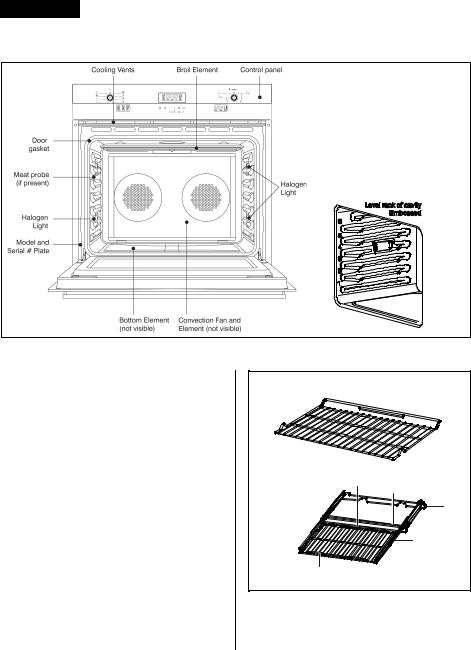
|
ENGLISH |
|
Use & Installation Manual |
|
|
Use & Installation |
Manual |
|
|
|
|
|
|
|
|
|
|
|
|
Product Features
Figure 1
About Your Oven
Above you will find an illustration of an oven showing the components of the oven.
Cooling Fan
The oven has a cooling fan to cool the control panel. You may hear this fan continue to run after cooking and/or cleaning has been completed. The fan will run as long as the oven is hot and the oven’s function selector is turned to any position other than “Off”.
This is normal operation.
Rack Positions
The oven has rack guides at six levels as shown in the illustration.
Each level guide consists of paired supports formed in the sidewalls on each side of the oven cavity. The rack should be positioned within the paired supports.
Always be sure to position the oven racks, etc. before turning the oven on.
Make sure that the rack(s) are level once they are in position.
|
Oven Rack Back |
|
Oven Rack Front |
|
|
|
Pan Stop |
|
|
Bottom Frame |
|
Extendable Rack |
Stop |
|
(if present) |
||
|
||
|
Slide Arm |
|
Handle |
|
Figure 2
6
6

|
Use & Installation Manual |
ENGLISH |
|
|
|
Use & Installation Manual |
|
|
|
|
|
|
|
|
|
Baking Elements
The oven uses two elements for baking: one located at the top of the oven and the second located below the floor of the oven cavity to provide ease in cleaning the oven cavity.
Grilling Element
The grilling element of the oven is located at the top of the oven cavity.
Do not touch the heating element or let oven gloves touch the grilling element.
Never use a towel or bulky cloth for an oven glove; they could catch on fire.
Convection Element
The convection elements (not visible) and fans are located at the back of the oven cavity. This element and fan combination performs the cooking when in the convection bake mode. When in any of the convection modes the fan is on, see Figure 1.
About Convection Ovens
In a conventional oven, the heat sources cycle on and off to maintain an average temperature in the oven cavity.
As the temperature gradually rises and falls, gentle air currents are produced within the oven. This natural convection tends to be inefficient because the currents are irregular and slow. In this convection system, the heat is “conveyed” by a fan that provides continuous circulation of the hot air.
This European Convection system provides state-of-the-art engineering and advanced design to create the finest convection oven. In standard convection ovens, a fan simply circulates the hot air around the food. The system is characterized by the combination of an additional heating element located around the convection fan and the venting panel that distributes heated air in three dimensions: along the sides, the top and the full depth of the oven cavity. This European Convection system aids in maintaining a more even oven temperature throughout the oven cavity.
The circulating air aids in speeding up the baking process and cooks the food more evenly. By controlling the movement of heated air, convection cooking produces evenly browned foods that are crispy on the outside yet moist inside. Convection cooking works best for breads and pastries as well as meats and poultry. Air-
leavened foods like angel food cakes, soufflés and cream puffs rise higher than in a conventional oven. Meats stay juicy and tender while the outside is flavorful and crisp.
By using European Convection, foods can be cooked at a lower temperature and cooking times can be shorter.
When using this mode, the standard oven temperature should be lowered by 25°F (15°C). Foods requiring less cooking time should be checked slightly earlier than normal. For best results, foods should be cooked uncovered, in low-sided pans to take advantage of the forced air circulation. When using the
Convection Roast mode, the standard oven temperature does not need to be reduced.
7
7
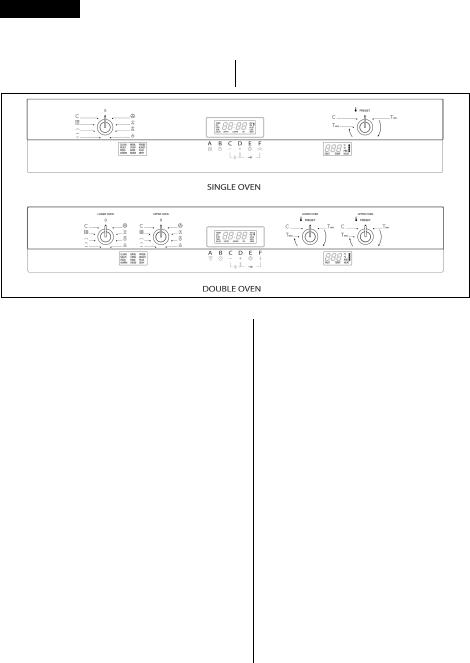
|
ENGLISH |
|
Use & Installation Manual |
|
|
Use & Installation |
Manual |
|
|
|
|
|
|
|
|
|
|
|
|
The Control Panels
The user interface has the following features: display, preheat light indicators, keys for
commands, cooking mode and temperature selectors.
Figure 3
Command Keys
B [TIME]: touch this key until “SET TIME” appears to set or change the time of day. Touch this key until “TIMER” appears to set, modify or clear the minute minder value.
Once a cooking function has been, touch this key until “TIME” appears in order to set, modify or cancel the cooking time. Touch this key until “STOP TIME” appears in order to set, modify or cancel the end of cooking time. Whenever one of the former modes has been enabled and its digits flash, touch or hold:
D [INC] key to increase the value.
C [DEC] key to decrease the value.
A (DOUBLE OVEN) - F (SINGLE OVEN) [FAST PREHEAT] When a cooking function has been selected, touch this key to enable the fast preheat mode. The fast preheat is not available for all functions.
A [OPTION] Touch this key to enable special functions, low temperature modes or to enter special menu.
E [LIGHT]: Touch it to switch the oven lights status.
F [UPPER/LOWER] (double oven): Touch this key to select the upper cavity if none is selected. If one of the two is already selected, touch it and switch to the other one.
8
Display
Central Red Display for time and miscellaneous functions: for time of day, minute minder, automatic cooking. AM/PM indication is also present.
Miscellaneous indications are also available to show which cavity is currently selected and whether any door has been locked, automatically for self-clean or manually by the user.
Red Display for Temperature indications: Degree unit (°C or °F) indication is present. It shows the temperature set-point for the current cooking mode, in the selected cavity.
Red Display with writings for Cooking Modes indication to indicate which function has been selected.
Knobs
Cooking mode selector (multifunction), with eight cooking modes + OFF position.
Cooking mode selector (thermal), with three cooking modes + OFF position.
Temperature selector with PRESET and CLEAN positions + continuous range between MIN and MAX values.
8
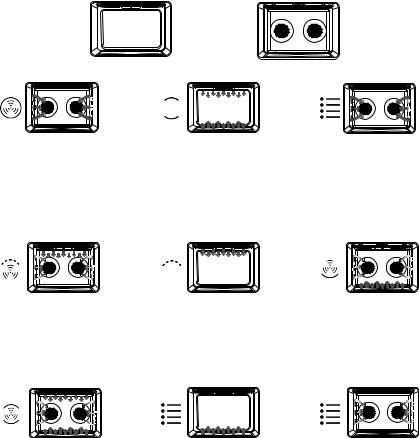
Use & Installation Manual |
ENGLISH |
|
|
|
|
Oven Modes
The following illustrations give an overview of what happens in the oven with each mode setting. The arrows represent the location of the heat sources during specific modes. The lower element is concealed under the oven floor.
Thermal Cavity |
Double Convection Cavity |
Convection Bake (CONV BAKE) |
Bake (BAKE) |
|
Set temperature: |
Set temperature: |
|
from 170 °F (75 °C) to 480 °F (250 °C) |
from 170 °F (75 °C) to 480 °F (250 °C) |
|
(preset position 325 °F (165 °C) |
(preset position 350 °F (175 °C) |
|
Convection Bake cooks with heat |
Is cooking with heated air. Both the |
|
from a ring element behind the back |
||
wall of the oven. The heat is |
upper and lower elements cycle to |
|
maintain the oven temperature. |
||
circulated throughout the oven by the |
||
convection fan. |
|
Dehydrate (CONV DEHY)
Set temperature:
from 120 °F (50 °C) to 160 °F (70 °C)
(preset position 140 °F (60 °C)
Dehydrating is similar to convection cooking but holds an optimum low temperature while circulating the heated air to remove moisture slowly for food preservation.
Convection Broil or Grill (CONV BROIL)
Set temperature:
from 170 °F (75 °C) to 480 °F (250 °C)
(preset position 450 °F (230 °C)
Convection Broil combines the intense heat from the upper element with the heat circulated by the convection fan.
Convection Roast (CONV ROAST)
Set temperature:
from 170 °F (75 °C) to 480 °F (250 °C)
(preset position 325 °F (165 °C)
Convection Roast uses the upper and lower elements and convection fan.
Broil or Grill (BROIL)
Set temperature: from L1 to L5
(preset position L3)
Broiling uses intense heat radiated from the upper element.
Proof (WARM)
Set temperature:
from 80 °F (25 °C) to 120 °F (50 °C)
(preset position 100 °F (35 °C)
Warming (WARM PLUS)
Set temperature:
from 130 °F (55 °C) to 210 °F (100 °C)
(preset position 170 °F (75 °C)
Proof and Warming use the lower elements to keep foods warm.
Pizza (PIZZA)
Set temperature:
from 170 °F (75 °C) to 480 °F (250 °C)
(preset position 450 °F (232 °C)
Is a special cooking mode with heated air. The lower elements cycle to cook Pizza.
Defrost (CONV)
Not used any heating element only convection fan is used to defrost foods.
9
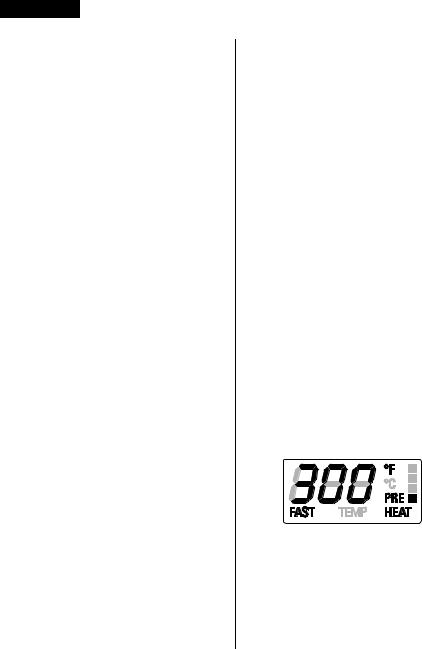
|
ENGLISH |
|
Use & Installation Manual |
|
|
Use & Installation |
Manual |
|
|
|
|
|
|
|
|
|
|
|
|
General Oven Information
Before using your oven for the first time remove all packing and foreign materials from the oven(s). Any material of this sort left inside may melt or burn when the appliance is used.
Flashing Symbols or Numbers
Signals an incomplete action that is in progress (locking the door, preheat, etc.) or an incomplete setting that calls for another input.
Beeps
Signals that more information must be entered or confirms the receipt of an entry. Beeps also signal the end of a function or an oven fault.
Locking the door
It’s displayed steadily when the door is locked. The symbol flashes when the latch is moving in order to lock or unlock the door. Do not attempt to open the door at this time. Door can be opened when the symbol no longer appears. “AUTO LOCK” appears when the door has been locked automatically due to self-clean mode. “USER LOCK” is displayed when the door has been locked manually by the user, for example to prevent children from having free access to the oven cavity. Hold both the [INC] and [DEC] keys for 3 seconds. The latch will lock the door. Repeat the same operation to unlock.
Locking the keyboard
Hold both the keys indicated by “KEYBD. LOCK” legend for 3 seconds. Commands are now locked and “SENS LOCK” will be displayed every time you touch any keys. Repeat the same operation for 3 seconds to unlock the keyboard.
Power Failure
After the power returns to the oven, the clock displays the time 12.00AM.
Default Settings
The cooking modes automatically select a suitable temperature when the selector is in the preset position. These can be changed when a different one is needed. It’s also possible to set a user option in order to save the last used temperature per every cooking mode.
F Failure Number Codes
These codes are displayed when the electronic control detects a problem in the oven or in the electronics.
10
Convection Fan
The convection fan operates during any convection mode. When the oven is operating in the convection mode, the fan will turn off automatically when the door is opened. The convection fan always runs during the preheat time.
Component Cooling Fan
Activates during any cooking or self-cleaning mode to cool inner components and outer door surfaces. This air is exhausted through the vent located above the oven door. It continues to run until components have cooled sufficiently. The cooling fan speed is high in self-clean and whenever the internal components temperature becomes high.
Preheat and Boost
Whenever a cooking mode is set and the oven is heating, the “PREHEAT” writing appears in the temperature display: the vertical bar indicates, in four steps, when the oven reaches the 25%, 50%, 75%, 100% of the set-point temperature.
As soon as the 100% is reached, the control sounds an “end of preheat” tone and the “PREHEAT” writing disappears.
When it’s necessary to heat up the oven rapidly, a Boost mode is available: it uses the heating elements and the convection fan in a special way, in order to reduce the heating time as long as possible.
After having set one of the cooking functions for
which the fast preheat is available, touch the [BOOST] key, the “FAST” writing is shown in
addition to the“PREHEAT” one.
As soon as the set-point temperature is reached, the control sounds an “end of preheat” tone and both “FAST” and “PREHEAT” writings disappear. The oven switches automatically to the desired cooking mode that was previously set: put the food inside now.
10

|
Use & Installation Manual |
ENGLISH |
|
|
|
Use & Installation Manual |
|
|
|
|
|
|
|
|
|
General Oven Tips
Preheating the Oven
•Preheat the oven when using the Bake, Convection Bake and Convection Roast modes.
•Use BOOST mode when a short time is necessary to preheat the oven.
•Selecting a higher temperature does not shorten the preheat time.
•Preheating is necessary for good results when baking cakes, cookies, pastry and breads.
•Preheating will help to sear roasts and seal in meat juices.
•Place oven racks in their proper position before preheating.
•During preheating, the selected cooking temperature is always displayed.
•A beep will confirm that the oven is preheated and the “PREHEAT” writing will turn off.
Operational Suggestions
•Use the cooking charts as a guide.
•Do not set pans on the open oven door.
•Use the interior oven lights to view the food through the oven door window rather than opening the door frequently.
Utensils
•Glass baking dishes absorb heat. Reduce oven temperature 25 °F (15 °C) when baking in glass.
•Use pans that give the desired browning. The type of finish on the pan will help determine the amount of browning that will occur.
•Shiny, smooth metal or light non-stick / anodized pans reflect heat, resulting in lighter, more delicate browning. Cakes and cookies require this type of utensil.
•Dark, rough or dull pans will absorb heat resulting in a browner, crisper crust. Use this type for pies.
•For brown, crisp crusts, use dark non-stick / anodized or dark, dull metal utensils or glass bake ware. Insulated baking pans may increase the length of cooking time.
•Do not cook with the empty broiler pan in the oven, as this could change cooking performance. Store the broil pan outside of the oven.
Oven Condensation and Temperature
•It is normal for a certain amount of moisture to evaporate from the food during any cooking process. The amount depends on the moisture content of the food. The moisture may condense on any surface cooler than the inside of the oven, such as the control panel.
•Your new oven has an electronic temperature sensor that allows maintaining the selected temperature accurately. Your previous oven may have had a mechanical thermostat that drifted gradually over time to a higher temperature. It is normal that you may need to adjust your favorite recipes when cooking in a new oven.
High Altitude Baking
•When cooking at high altitude, recipes and cooking time will vary from the standard.
Oven Racks
•The oven has rack guides at six levels as shown in the illustration on Page 6.
•Rack positions are numbered from the bottom rack guide (#1) to the top (#6).·
•Check cooking charts for best rack positions to use when cooking.
•Each level guide consists of paired supports formed in the walls on each side of the oven cavity.
•Always be sure to position the oven racks before turning on the oven. Make sure that the racks are level once they are in position.
Please refer to illustration on Page 6 if there is any question as to which side is the front of the rack.
•The racks are designed to stop when pulled forward to their limit.
CAUTION
Never use aluminum foil to cover the oven racks or to line the oven. It can cause damage to the oven liner if heat is trapped under the foil.
Make sure you do not force it to avoid damage to the enamel.
11
11
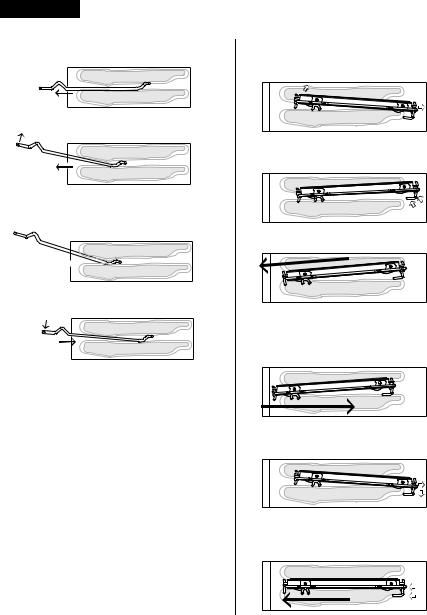
|
ENGLISH |
|
Use & Installation Manual |
|
|
Use & Installation |
Manual |
|
|
|
|
|
|
|
|
|
|
|
|
To remove oven rack from the oven:
1.Pull rack forward
2.Lift rack up at front and then remove it
To replace an oven rack:
1.Place rear of rack between rack level guides
2.While lifting front of rack, slide rack in all the way while lowering the front
Oven Extendable Racks
•The extendable rack allows for easier access to cooking foods. It extends beyond the standard flat rack bringing he food closer to the user.
CAUTION
When the rack is outside of the oven, slide arms do not lock. They could unexpectedly extend if the rack is carried incorrectly.
Extending slide arms could cause injury. Rack should only be held or carried by grasping the sides.
NOTE: Always remove the extendable rack before self-cleaning the oven.
To avoid burns, pull rack all the way out and lift pan above handle when transferring food to and from oven.
12
To remove extendable rack from the oven:
1.Lift of rack slightly and push it until the stop release
2.Raise back of rack until frame and stop clear rack guide
3.Pull rack down and out
To replace an extendable rack:
1.Grasp rack firmly on both sides. Place rack (including frame) above desired rack guide
2.Push all the way in until the back of the rack drops into place
3.Pull both sections forward until stops activates. Rack should be straight and flat, not crooked
12
